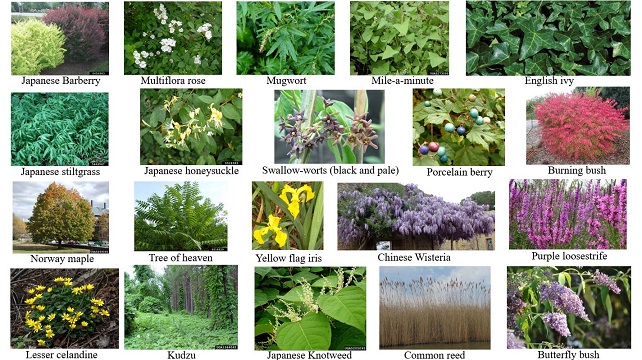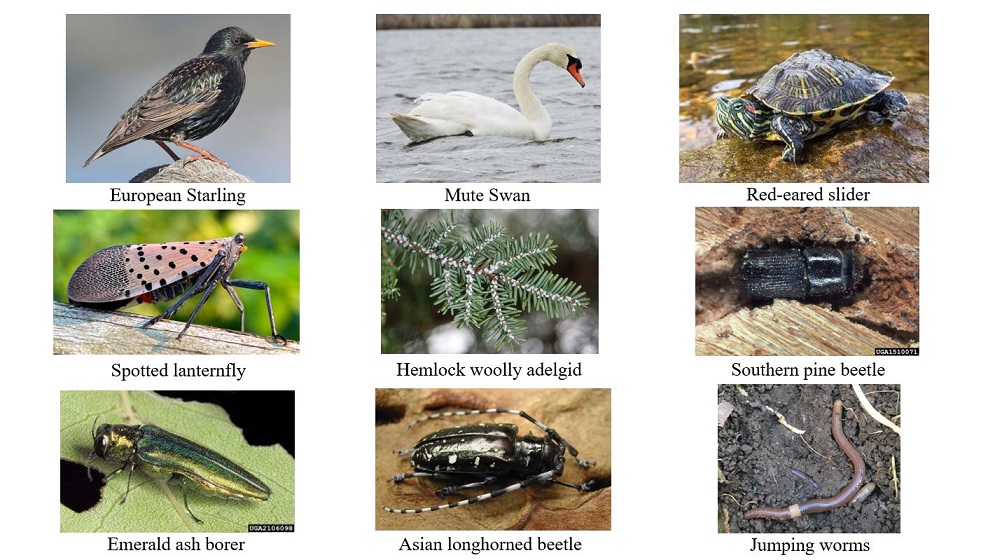Our Services > Sustainability Programs > Invasive Species > Invasive Species
Invasive Species
What is an invasive species?
Non-native plants, animals or other organism that cause harm to our local ecosystems, the economy or human health. They are threats to Long Island's biodiversity, agriculture and outdoor recreation. By learning about these species, removing them, reporting them and educating others, we can all help to prevent and limit their spread.
Common Invasive Plants

Click on the links below to learn more about each species including description, impact, biology, distribution and management options.
Common Invasive Animals

Click on the links below to learn more about each species including description, impact, biology, distribution and management options.
How You Can Help
- Don't plant invasive species, remove invasive plants, and plant native plants. Native plants are those that historically and naturally occur in an area and tolerate the climate of the local environment. They also have important evolutionary relationships with the wildlife in that area and provide many environmental benefits. Here are some native alternatives to common invasive landscaping plants (for more information on native plants click HERE):
| Invasive Plant |
Native Alternatives |
|
Butterfly bush
|
New York Ironweed (Vernonia noveboracensis), New England Aster (Symphyotrichum novae-angliae), Blazing star (Liatris spicata), Anise Hyssop (Agastache foeniculum), Swamp Milkweed (Asclepias incarnata), Sweet Pepperbush (Clethra alnifolia) |
| Japanese barberry |
Ninebark (Physocarpus opulifolius), Northern Spicebush (Lindera benzoin), Black chokeberry (Aronia melanocarpa), Winterberry (Ilex verticillata) |
| Multiflora rose |
Carolina rose (Rosa carolina), Virginia rose (Rosa virginiana), Flowering raspberry (Rubus odoratus) |
| English ivy |
Scarlet Strawberry (Fragaria virginiana), Barren Strawberry (Geum fragaroides), Foamflower (Tiarella cordifolia), Lady fern (Athyrium filix-femina), Wild ginger (Asarum canadense) |
| Burning bush |
Red Chokeberry (Aronia arbutifolia), Black chokeberry (Aronia melanocarpa), Highbush blueberry (Vaccinium corymbosum), Lowbush blueberry (Vaccinium angustifolium), American Cranberry (Viburnum opulus var. americanum, Winterberry (Ilex verticillata) |
| Yellow flag iris |
Blue flag iris (Iris versicolor), Cardinal Flower (Lobelia cardinalis), Great Blue Lobelia (Lobelia siphilitica), Stiff goldenrod (Solidago rigida) |
| Chinese Wisteria |
American Wisteria (Wisteria frutescens) |
| Purple loosestrife |
Foxglove beardtongue (Penstemon digitalis), Garden Phlox (Phlox paniculata), Anise Hyssop (Agastache foeniculum) |
- Watch out for these invasive insect species in your landscape. Remove them if possible and report sightings to iMapInvasives (see below):
- Spotted Lanternfly
- Emerald Ash Borer
- Jumping Worms
- Asian Longhorned Beetle
- Submit any invasive plant or animal sightings to iMapInvasives NY, which is an online, collaborative, GIS-based database and mapping tool that serves as the official invasive species database for NY State. Learn more HERE.
For more information visit these pages: